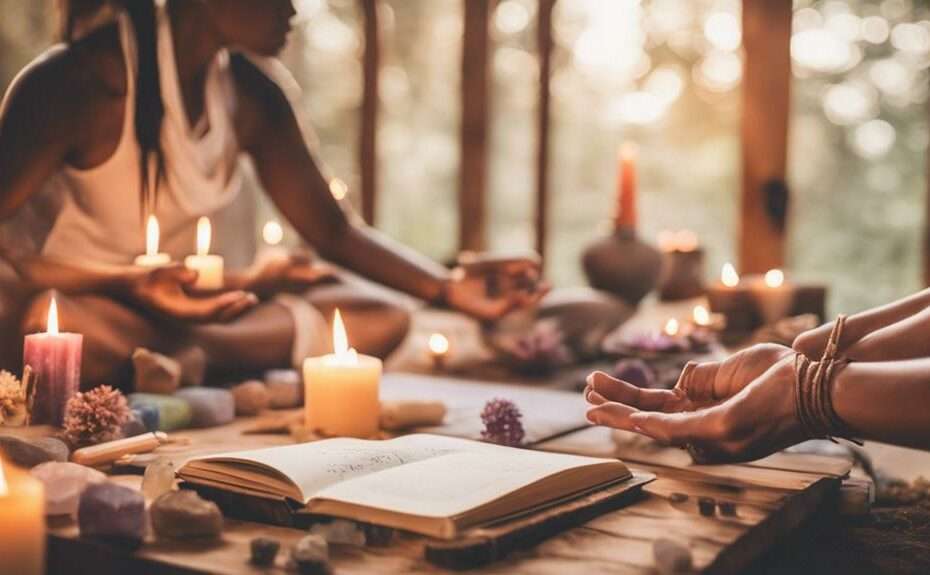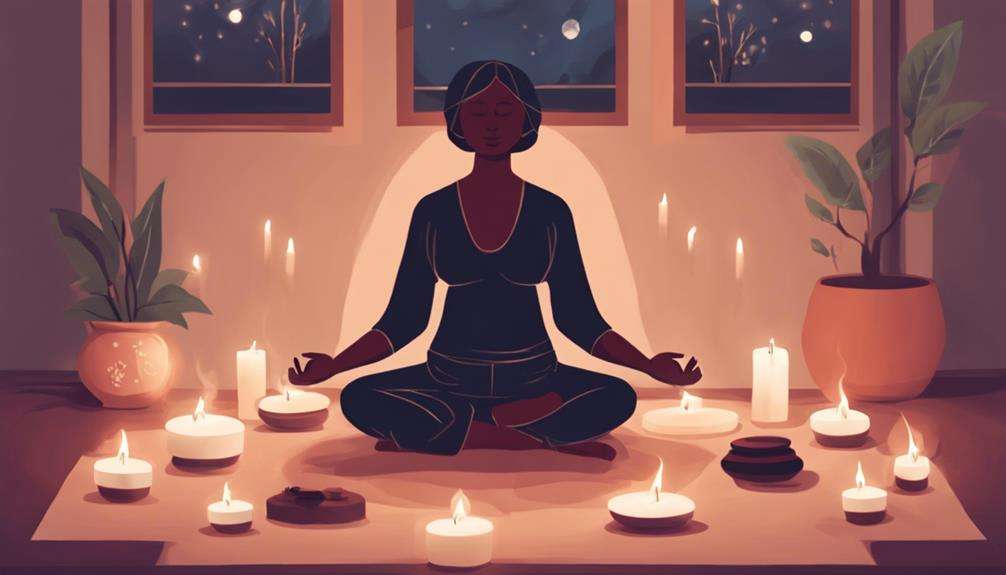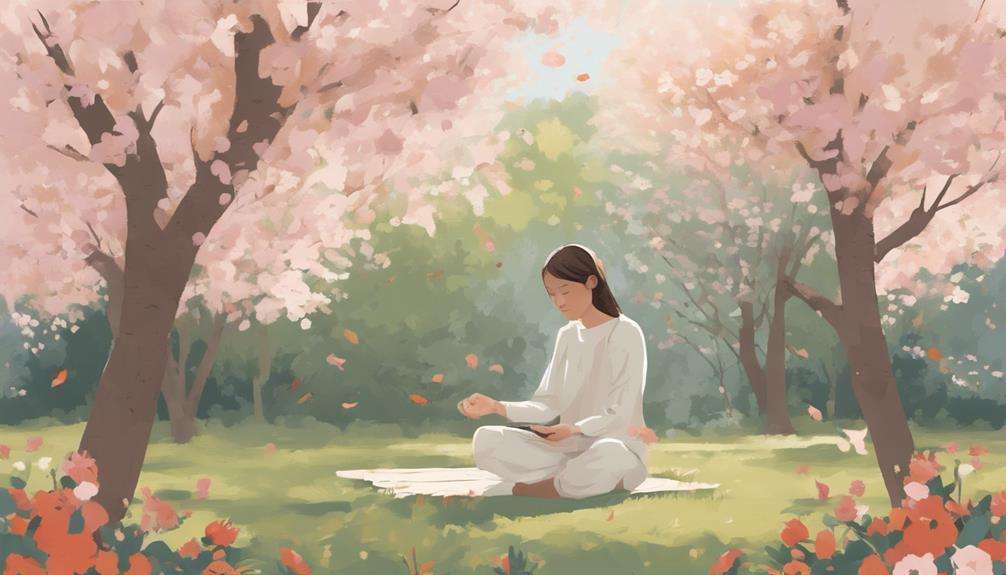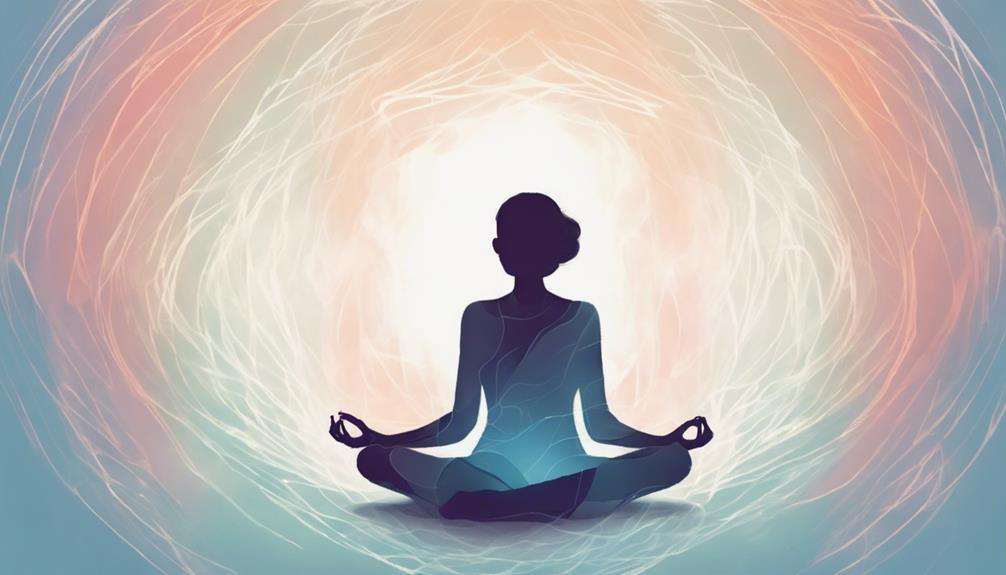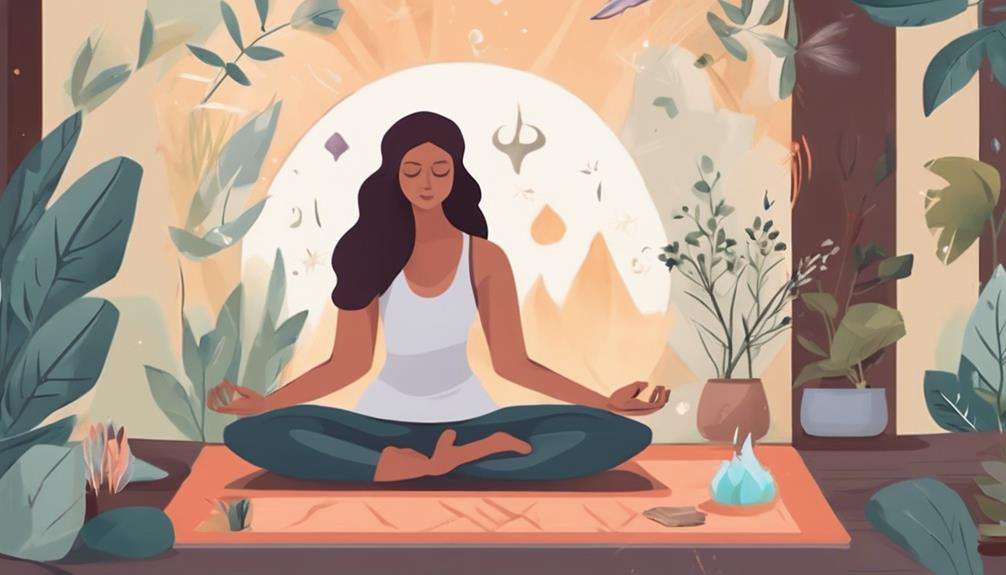Imagine a scenario where a person struggling with anxiety finds solace in a simple breathing exercise. The calmness that washes over them as they focus on their breath, gradually easing the tension in their body and mind.
But what if there were more techniques beyond just breathing exercises that could offer relief from anxiety? Techniques that tap into different aspects of your being, providing a comprehensive approach to managing anxiety.
Stay tuned to discover how a holistic approach encompassing various practices can offer a well-rounded strategy for anxiety relief.
Key Takeaways
- Yoga and meditation techniques effectively reduce anxiety by promoting relaxation and mindfulness.
- Guided visualization and imagery aid in calming the mind and reducing stress hormones.
- Mindfulness practices like meditation and breathing exercises enhance emotional regulation and reduce anxiety symptoms.
- Physical techniques such as Tai Chi and Progressive Muscle Relaxation help release tension and improve the body-mind connection.
Yoga for Anxiety
Embracing yoga as a practice for anxiety relief can significantly alleviate symptoms and nurture a sense of calm within you. By engaging in yoga, you aren't only moving your body but also working towards balancing your mind.
Yoga has been proven to lower cortisol levels, the stress hormone, which is often elevated in times of anxiety. This reduction in cortisol helps in managing anxiety better and promoting a more stable mood. The specific yoga poses designed for relaxation, such as child's pose, forward fold, and corpse pose, can aid in calming both your body and mind.
These poses, combined with breathing techniques incorporated in yoga practice, emphasize mindfulness and relaxation, essential components in alleviating anxiety. Studies have highlighted the positive impact of yoga on reducing anxiety disorders and improving overall mental health.
Meditation Techniques for Calmness
If you're seeking calmness in the midst of anxiety, meditation can offer you a path to peace.
By practicing guided visualization, mindfulness techniques, and intentional breathing exercises, you can soothe your mind and body.
These methods can help you cultivate a sense of tranquility and reduce the grip of anxiety on your daily life.
Guided Visualization Benefits
To experience a sense of calmness and reduce anxiety, one effective technique is guided visualization, where you imagine a peaceful scene or outcome. This practice is known to promote relaxation, lower stress hormones, and decrease heart rate, leading to enhanced feelings of calmness.
Research indicates that guided visualization not only improves mood and reduces anxiety levels but also enhances overall well-being. It's commonly integrated into mindfulness practices, meditation, and therapy sessions to assist individuals in managing their anxiety effectively.
Mindfulness Meditation Techniques
Engage in mindfulness meditation techniques to cultivate a state of calmness and enhance your overall well-being. Here are four mindfulness meditation techniques that can help reduce stress, alleviate symptoms of anxiety and depression, and promote overall well-being:
- Body Scan: Focus your attention on different parts of your body, gradually relaxing each area.
- Loving-Kindness Meditation: Direct feelings of compassion and love towards yourself and others.
- Mindful Breathing: Pay attention to your breath, inhaling and exhaling slowly and deeply.
- Present Moment Awareness: Stay fully present in the moment, observing thoughts and sensations without judgment.
Regular practice of mindfulness meditation can lead to positive brain changes, enhancing memory, empathy, and stress regulation.
Breathing Exercises for Relaxation
As you explore breathing exercises for relaxation, you'll discover powerful meditation techniques that can bring calmness and balance to your mind and body.
Deep breathing exercises trigger the body's relaxation response, reducing stress and anxiety levels. Engaging in mindful breathing methods like diaphragmatic breathing enhances oxygen flow, soothes the mind, and decreases heart rate.
Box breathing, with its equal counts of inhaling, holding, exhaling, and holding breath, promotes relaxation – a technique used by Navy SEALs.
Combining progressive muscle relaxation with deep breathing releases tension, fostering a profound sense of calmness. Embracing rhythmic breathing patterns not only aids in emotional regulation but also boosts focus and overall well-being.
Practice these techniques to cultivate tranquility and serenity within yourself.
Breathing Exercises for Relaxation
When seeking relief from anxiety, consider incorporating breathing exercises into your daily routine as a powerful tool for relaxation and stress reduction. Deep breathing techniques offer simple yet effective ways to promote relaxation, calmness, and overall well-being.
- Activate the Relaxation Response: Deep breathing exercises help trigger the body's relaxation response, reducing heart rate and blood pressure.
- Try Diaphragmatic Breathing: Practice deep inhales through the nose and slow exhales through the mouth to engage the diaphragm and promote relaxation.
- Explore Box Breathing: This method involves inhaling, holding, exhaling, and holding the breath in equal counts, aiding in stress reduction.
- Consistent Practice: Dedicate a few minutes daily to deep breathing to experience the benefits of reduced stress, anxiety relief, and improved well-being.
Mindfulness Practices for Inner Peace

To cultivate inner peace through mindfulness practices, focus on embracing the present moment without judgment. Mindfulness techniques, such as mindfulness meditation, offer powerful tools for anxiety relief and promoting mental well-being. By engaging in mindfulness practices, you can reduce anxiety symptoms and enhance your coping mechanisms. Research supports the effectiveness of mindfulness in decreasing anxiety and depression levels while improving overall mental health. Techniques like deep breathing, body scans, and mindful walking can help calm your mind and body, fostering relaxation and inner peace.
Mindfulness-based stress reduction (MBSR) programs are structured approaches that have been successful in reducing anxiety and increasing self-awareness. Regular practice of mindfulness not only aids in managing anxiety in the short term but also provides long-term benefits, including heightened self-awareness and a sense of inner peace. Embracing mindfulness as part of your daily routine can lead to significant improvements in your mental well-being and overall quality of life.
Tai Chi for Stress Relief
If you're seeking a gentle yet effective way to alleviate stress and anxiety, Tai Chi might be just what you need.
The calming rhythm of Tai Chi movements, combined with focused breathing, can help you achieve a sense of relaxation and inner peace.
Tai Chi Benefits
Embrace the gentle yet powerful practice of Tai Chi for stress relief, known for its calming movements and soothing effects on the mind and body. Here are some benefits of Tai Chi for anxiety relief:
- Reduces stress and anxiety levels.
- Improves mood and helps in managing depression.
- Lowers cortisol levels, the stress hormone.
- Enhances relaxation through deep breathing and meditation techniques.
Tai Chi offers a holistic approach to anxiety relief by combining physical movements with mindfulness practices, promoting a sense of inner peace and overall well-being.
Regardless of your age or fitness level, Tai Chi can be a valuable tool in your journey towards a calmer mind and a more balanced life.
Tai Chi Techniques
Discover how Tai Chi techniques can bring calm and relief to your mind and body, nurturing a sense of inner peace and well-being.
Tai Chi, an ancient Chinese martial art, incorporates gentle movements, deep breathing, and meditation to promote relaxation and reduce stress. By engaging in Tai Chi for stress relief, you can effectively lower anxiety levels and improve overall well-being.
Regardless of age or fitness level, Tai Chi is accessible to all individuals seeking to manage anxiety through gentle movement. The slow and flowing motions of Tai Chi help soothe the mind, regulate breathing patterns, and release tension, aiding in reducing anxiety.
Moreover, Tai Chi practice has been scientifically linked to decreased cortisol levels, which are indicators of stress, making it a valuable technique for anxiety relief.
Progressive Muscle Relaxation Methods
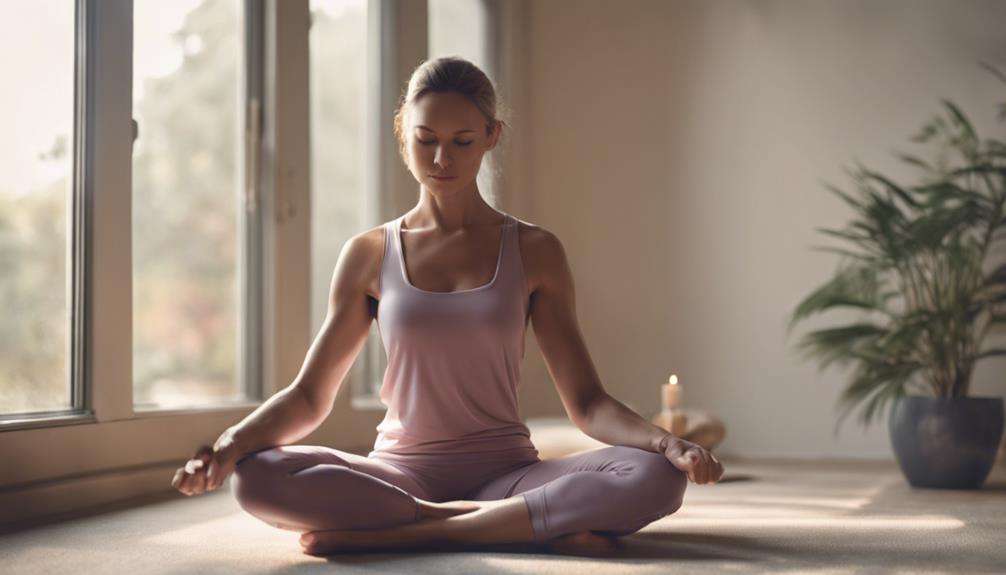
Engage in Progressive Muscle Relaxation (PMR) to alleviate physical tension and anxiety effectively. Here are four reasons why PMR can be beneficial for reducing stress and promoting relaxation:
- Reduce Physical Tension: By systematically tensing and releasing muscle groups, PMR helps you release built-up tension in your body.
- Lower Blood Pressure: PMR has been shown to help decrease blood pressure levels, promoting better cardiovascular health.
- Improve Sleep: Practicing PMR before bed can help calm your mind and body, leading to improved sleep quality.
- Decrease Anxiety Symptoms: PMR is a valuable tool in managing anxiety symptoms by promoting relaxation and reducing overall stress levels.
As you engage in PMR, focus on the body-mind connection, allowing yourself to become more attuned to your physical sensations and emotions. This technique isn't only a form of therapy for anxiety but also a way to enhance your overall well-being through simple yet powerful relaxation techniques.
Guided Imagery for Soothing Anxiety
Explore the calming power of guided imagery to soothe anxiety and promote a sense of tranquility and well-being within yourself.
Guided imagery is a relaxation technique that involves visualizing peaceful scenes to reduce anxiety and stress levels. By incorporating guided imagery into your routine, you can experience a decrease in heart rate and an overall sense of relaxation.
This practice isn't only beneficial for managing anxiety but also for improving mental health and enhancing your quality of life. Guided imagery is commonly used in therapy, meditation, and mindfulness practices to help individuals shift their focus away from anxious thoughts and towards positive images that evoke a sense of calmness.
Research supports the effectiveness of guided imagery in reducing anxiety symptoms and promoting a greater sense of well-being. So, take some time for yourself, close your eyes, and immerse yourself in the soothing world of guided imagery to nurture your mental health and find peace within.
Frequently Asked Questions
How I Cured My Anxiety Disorder Naturally?
You cured your anxiety disorder naturally by embracing mindfulness meditation, breathing exercises, and herbal remedies. Yoga and nature walks brought calm. Aromatherapy eased tension. Balanced diet, hydration, and good sleep supported your journey.
What Is the 3 3 3 Rule for Anxiety?
When feeling anxious, try the 3 3 3 Rule. Look around and name three things you see, hear, and feel. This grounding exercise can shift focus, calm your mind, and prevent panic.
What Calms Down Anxiety?
When anxiety strikes, try deep breathing, mindful meditation, nature walks, yoga poses, aromatherapy scents, guided imagery, progressive muscle relaxation, journaling thoughts, herbal teas, and creative expression. These practices can calm your mind and body.
What Is the 5 5 5 Method for Anxiety?
When anxiety strikes, try the 5 5 5 method: breathe in for 5, hold for 5, exhale for 5. This simple technique regulates your breath, triggers relaxation, and eases panic. Practice it anywhere for instant relief.
Conclusion
You've explored a variety of holistic techniques to manage anxiety, from yoga to guided imagery. By incorporating these practices into your daily routine, you can nurture your mental well-being and find inner peace.
Remember, self-care is key in your journey to combat anxiety. So, take a deep breath, embrace these holistic approaches, and watch your worries melt away like ice cream on a hot summer day.
You deserve to feel calm and centered. Keep practicing, and you'll thrive.
